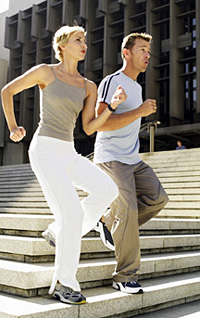
|  |  |  Health & Beauty Health & Beauty  
Exercising Just Got Easier for Busy People, Study Shows
 Jane Christmas - McMaster University Jane Christmas - McMaster University
go to original
March 14, 2010


| | There is no free lunch; duration must increase as intensity decreases. |  |
Hamilton, Canada - If you're the type of person who invokes the "not enough time" clause when it comes to exercising, it's time to find a new excuse. Researchers who have been studying interval training have found that it not only takes less time than what is typically recommended, but the regimen does not have to be "all out" to be effective in helping reduce the risk of such diseases at Type 2 diabetes.

The study appears in the March issue of The Journal of Physiology.

"What we've been able to show is that interval training does not have to be 'all out' in order to be effective and time-efficient," says Martin Gibala, professor and chair of the Department of Kinesiology at McMaster University. "While still a very demanding form of training, the exercise might be more achievable by the general public - not just elite athletes - and it certainly doesn't require the use of specialized laboratory equipment."

Since Gibala's first study on interval training was published five years ago, a growing body of research has zeroed in on this particular style of exercise in which you train hard but for less time.

Previous research by the McMaster group involved 30 seconds of maximal pedaling on a special bike followed by four minutes of recovery, and repeated 4-6 times. The new study involves eight to 12 one-minute bouts of exercise on a standard stationary bicycle at a relatively lower intensity with rest intervals of 75 seconds, for a total of 20-25 minutes per session. The workload was still above most people's comfort zone - about 95% of maximal heart rate — but only about half of what can be achieved when people sprint at an all-out pace.

"That is the trade-off for the relatively lower intensity," says Gibala. "There is no free lunch; duration must increase as intensity decreases."

While the total amount of exercise performed was higher than in Gibala's previous interval training studies, the overall time commitment was still lower than what is typically recommended by public health agencies.

Subjects used in the study performed six training sessions over 14 days. After the two week training period, the subjects showed the same benefits that Gibala's team has previously observed after traditional, long-duration endurance training: improved exercise performance and muscular adaptations that are linked to reduced risk of diseases such as Type 2 diabetes.

• • •

The study was made possible by funding from the Natural Sciences and Engineering Research Council of Canada.

Gibala is currently taking his research a step further by studying the effects of interval training on middle-aged and elderly participants who are non-traditional exercisers.

chrisja(at)mcmaster.ca |

 |
|  |



